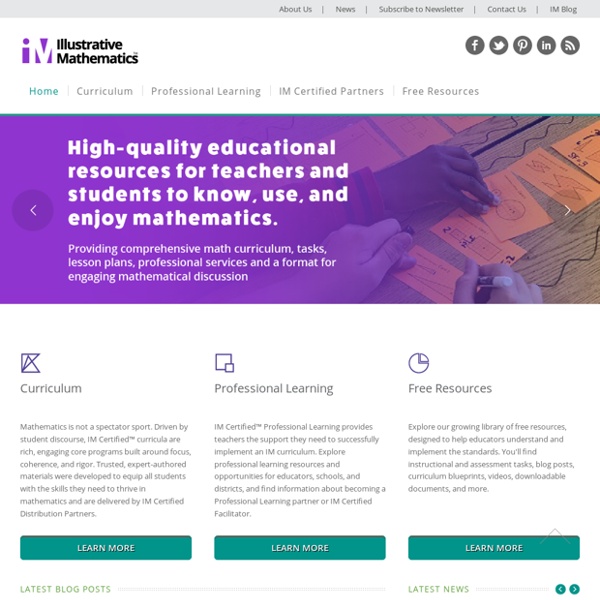



https://www.illustrativemathematics.org/
Related: common core math • Mathematics Unit & Lesson Plans • Curriculum • 4th Grade Math whole group instuctionMathlanding Educator Review Learning Scores Engagement Is the product stimulating, entertaining, and engrossing? Will kids want to return? 3 Math in Daily Life When you buy a car, follow a recipe, or decorate your home, you're using math principles. People have been using these same principles for thousands of years, across countries and continents. Whether you're sailing a boat off the coast of Japan or building a house in Peru, you're using math to get things done.
4th grade math games The 4th grade math games on this website focus on several important topics such as adding and subtracting decimals and fractions with common denominators, rounding decimals, measuring angles with appropriate units and tools, understanding the characteristics of geometric plane and solid figures, using common measurement units to determine weight, and using tables, graphs, and charts to record and analyze data. Fourth grade students, are you ready to show off your math skills? Try one of these games! Properties of Addition - Soccer Game In this fun soccer math game, 4th grade students will identify and use different properties of addition. Math Magician Multiples Game
NCTM Brain Teasers Sliding Triangle The triangle at left lies on a flat surface and is pushed at the top vertex. The length of the congruent sides does not change, but the angle between the two congruent sides will increase, and the base will stretch. Initially, the area of the triangle will increase, but eventually the area will decrease, continuing until the triangle collapses. What is the maximum area achieved during this process? And, what is the length of the base when this process is used to create a different triangle whose area is the same as the triangle above? Fun Kids Online Math Games "Sheppard offers everything from early math to pre-algebra. The lessons include interactive activities to practice concepts. Students can shoot fruit, pop balloons, and even play math man (the math version of pac man!). Fractions, place value, money, and basic operations are some of the areas that are covered.
Math Programs: How They Rate on Common-Core Alignment Based on market share and states’ recommendations, EdReports.org selected 20 math instructional series to review for common-core alignment. (For reporting purposes, K-5 and 6-8 texts from the same publisher were considered separate series.) Small teams of educators scored the digital and print texts on focus, coherence, rigor, and usability. Atlas - Home You are using an unsupported internet browser. Atlas may not function as designed. Please download one of these updated browsers: Don't show this againAtlas is phasing out support for your internet browser.
3-5 Formative Instructional and Assessment Tasks - 4.NF.3-4.NF.4 Build fractions from unit fractions by applying and extending previous understandings of operations on whole numbers.4.NF.3 Understand a fraction a/b with a > 1 as a sum of fractions 1/b. a. Understand addition and subtraction of fractions as joining and separating parts referring to the same whole. b. Decompose a fraction into a sum of fractions with the same denominator in more than one way, recording each decomposition by an equation. Justify decompositions, e.g., by using a visual fraction model. Examples: 3/8 = 1/8 + 1/8 + 1/8 ; 3/8 = 1/8 + 2/8 ; 2 1/8 = 1 + 1 + 1/8 = 8/8 + 8/8 + 1/8. c.
Responding to Student Progress One area where I need a lot of growth is responding to the progress of my students. Specifically, what are the next steps after I’ve identified the level of understanding in certain concepts? I recently decided to tackle this challenge during our review days for the state assessment. The goal was to review the most tested concepts, but I also wanted the kids to work on their biggest struggle areas.